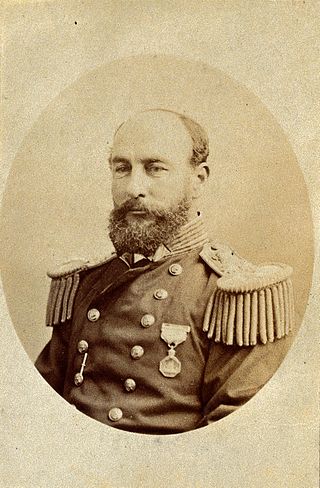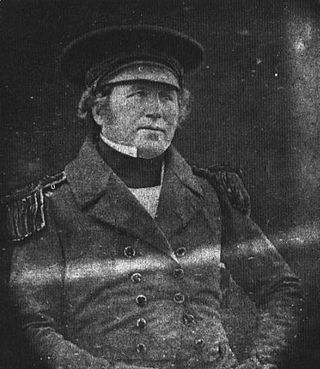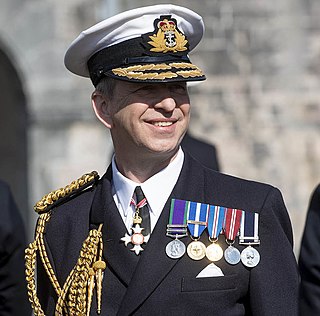
Vice-Admiral Sir George Strong Nares was a Royal Navy officer and Arctic explorer. He commanded the Challenger Expedition, and the British Arctic Expedition. He was highly thought of as a leader and scientific explorer. In later life he worked for the Board of Trade and as Acting Conservator of the River Mersey.
Major General Sir Douglas Anthony Kendrew,, often known as Joe Kendrew especially during his rugby career, was an officer of the British Army who served in the Second World War and the Korean War, an international rugby player, and the 22nd Governor of Western Australia from 1963 to 1974.
North Ice was a research station of the British North Greenland Expedition on the inland ice of Greenland. The coordinates of the station were 78°04′N38°29′W, at an altitude of 2,341 metres (7,680 ft) above sea level. The British North Greenland Expedition had its main base camp in Britannia Lake, Queen Louise Land. It was led by Commander James Simpson RN. The station recorded a temperature of −66.1 °C (−87.0 °F) on 9 January 1954, which made it the lowest temperature ever recorded in North America up until that time. It was superseded by an observation of −69.6 °C (−93.3 °F) at the Greenland Ice Sheet on 22 December 1991. The name of the station contrasts to the former British South Ice station in Antarctica.

HMS Hecla was a Royal Navy Hecla-class bomb vessel launched in 1815. Like many other bomb vessels, she was named for a volcano, in this case Hekla in southern Iceland. She served at the Bombardment of Algiers in 1816. Subsequently, she took part in three expeditions to the Arctic. She then served as a survey vessel on the coast of West Africa until she was sold in 1831. She became a merchantman and in 1834 a Greenland whaler. She was wrecked in 1840.

Francis Rawdon Moira Crozier was an Irish officer of the Royal Navy and polar explorer who participated in six expeditions to the Arctic and Antarctic. In May 1845, he was second-in-command to Sir John Franklin and captain of HMS Terror during the Franklin expedition to discover the Northwest Passage, which ended with the loss of all 129 crewmen in mysterious circumstances.
Inspector-General Belgrave Ninnis was a Royal Navy surgeon, surveyor, Arctic explorer, and leading Freemason, from London. He graduated as a Doctor of Medicine from the University of St Andrews in 1861, and the same year entered the navy as an Assistant Surgeon. From 1864 to 1866, Ninnis served as part of a surveying expedition to the Northern Territory of South Australia, helping to chart the area to the west of the Adelaide River and returning biological specimens to Adelaide for study. In 1867 Ninnis was appointed to Greenwich Hospital, and in 1875 he joined the British Arctic Expedition under Captain Sir George Nares, serving as Staff-Surgeon on HMS Discovery. When disease spread among the expedition's dogs, Ninnis was charged with investigating the cause; his findings later formed the basis of a published work. At the conclusion of the expedition in 1876 he received the Arctic Medal for his service, and was promoted to Fleet-Surgeon.
Commander Cortlandt James Woore Simpson, CBE, DSC, PM was an English polar explorer and naval officer.

HMS Griper was a Bold-class gun-brig of the British Royal Navy, built in 1813 by Mark Williams and John Davidson at Hythe. She participated in the 1819 expedition to the Arctic led by William Parry, made a voyage to Greenland and Norway in 1823, and took part in Parry's third expedition in 1824 as a support ship. Her crew in 1819, 1823, or 1824, qualified for the "Arctic Medal", which the Admiralty issued in 1857. She was eventually broken up in 1868.

Admiral of the Fleet Sir William Henry May was a Royal Navy Officer. As a junior officer he took part an expedition to rescue Commander Albert Markham who had got into difficulty trying to reach the North Pole via Smith Sound, the sea passage between Greenland and Canada's northernmost island, Ellesmere Island.

Commander Joseph Russell Stenhouse, DSO, OBE, DSC, RD, RNR (1887–1941) was a Scottish-born seaman, Royal Navy Officer and Antarctic navigator, who commanded the expedition vessel SY Aurora during her 283-day drift in the ice while on service with the Ross Sea Party component of Sir Ernest Shackleton's Imperial Trans-Antarctic Expedition in 1914–17. After Aurora's escape from the ice he brought her safely to New Zealand, but was thereafter replaced as the vessel's commander. He later served with distinction in the Royal Navy during both World Wars.

HMS Alert was a 17-gun wooden screw sloop of the Cruizer class of the Royal Navy, launched in 1856 and broken up in 1894. She was the eleventh ship of the Royal Navy to bear the name, and was noted for her Arctic exploration work; in 1876 she reached a record latitude of 82° North. Alert briefly served with the US Navy, and ended her career with the Canadian Marine Service as a lighthouse tender and buoy ship.

Colonel Sir John Edmond Hugh Boustead KBE CMG DSO MC & Bar was a British military officer, modern pentathlete, and diplomat who served in numerous posts across several Middle Eastern countries, including ambassador to Abu Dhabi from 1961 to 1965. The son of a tea planter from Sri Lanka, Boustead began his career with the Royal Navy, but soon joined the British Army to fight in the trenches during World War I, where he earned his first of two Military Crosses. Following an appearance at the 1920 Summer Olympics, Boustead spent several years as a mountaineer and explorer prior to being appointed commander of the Sudan Camel Corps, with whom he served through World War II. He then embarked on a diplomatic career until his 1965 retirement and published an autobiography, The Wind of Morning, in 1971, nine years prior to his death in Dubai.
HMS North Star was a 28-gun Atholl-class sixth-rate post ship built to an 1817 design by the Surveyors of the Navy. She was launched in 1824. North Star Bay, a bay in Greenland, was named in honour of this ship.

Vice Admiral Jeremy Paul Kyd, is a former senior Royal Navy officer. He has served as the Lieutenant Governor of Jersey since October 2022. He formerly served as Fleet Commander from March 2019 to September 2021.

Queen Louise Land is a vast mountainous region located west of Dove Bay, King Frederick VIII Land, northeastern Greenland. Administratively it is part of the Northeast Greenland National Park zone.

Surgeon Captain Edward W. Bingham, was a British Royal Navy officer and polar explorer who had the rare third clasp added to his Polar Medal.

HMS Desperate was originally slated to be built to the Sampson designed steam vessel rated as a Steam Vessel First Class (SV1); however, the Admiralty, first rerated the vessels as First Class Sloops on 19 April 1845 then on the 9 May 1845, she was ordered as First-Class screw sloops to be built from a design of Sir William Symonds, Surveyor of the Navy. She would be a 10-gun vessel with 400 NHP engines. She served in the Baltic during the Crimean war, and as a store ship to Edward Augustus Inglefield's Arctic expedition. She was broken up by 1865.

Britannia Lake, is a lake in King Frederick VIII Land, Northeastern Greenland. The lake and its surroundings are part of the Northeast Greenland National Park zone.

Britannia Glacier is a glacier in Queen Louise Land, northeastern Greenland. Administratively it belongs to the Northeast Greenland National Park.














